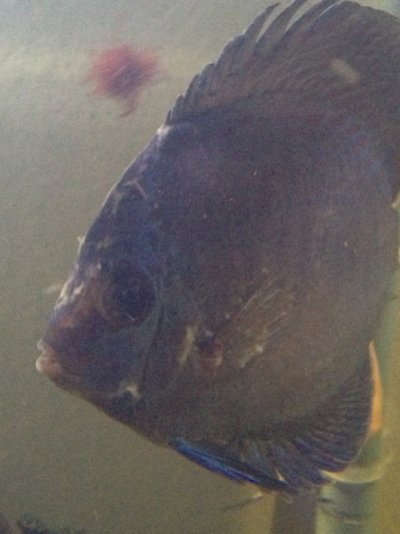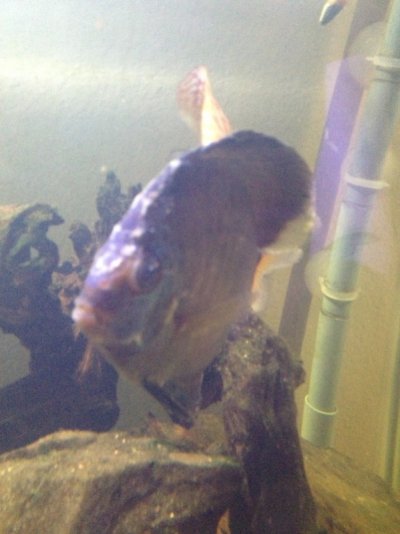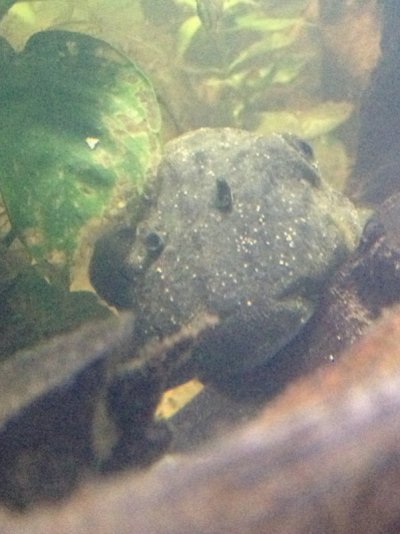ArtesiaWells
Aquarium Advice Addict
- Joined
- Jun 1, 2012
- Messages
- 1,392
I am uncertain as to the best place on the forum for this question to be posted, but since it pertains to the health of my goldfish, I figured the "Unhealthy Fish" section may have been more ideal; at any rate, my apologies if this is not the ideal area...
My Black/Gold Moor has been exhibiting signs of an "ulcer" outbreak of some kind, in which "pimple-like" formations have jutted out from beneath her scales, but which also disappear just as quickly...for the last few weeks, she has shown these signs, as if "whiteheads" are trying to burst from beneath her scales, and there was even a "cotton-y white" looking growth near her hind fins, but, as I said, these all seem to "pop" or disappear on their own. Making things even more confusing is the fact that she shows absolutely NO signs of distress during these periods -- she is swimming happily and eating and showing no symptoms of stress or sickness...
Currently, she seems to be doing very well, and down to just one smallish pimple that looks like it's trying to break its way from beneath her scales...
Here's where things get a bit tricky: One of the HOB filters I run on my 60 gallon goldfish tank, an Aqueon QuietFlow 55, takes dual carbon "cartridges" made of floss, and I have been running the same two cartridges in the filter since setting up the new tank, which has been for about two months or so...Aqueon recommends changing these cartridges every six or so weeks, claiming the blue plastic "bio grids" and "bio holsters" house the beneficial bacteria, thus allowing the cartridges to be thrown away and replaced when they get nasty looking (actually, last week during a partial mid-week water change, I swapped out ONE of the cartridges for a new one -- this filter takes TWO carts -- with the hope of maintaining any BB colonies that may have been residing in the one I didn't take out...I figured I would wait about four or five weeks before swapping out the second, in a "staggered" process...).
From everything I have been told about this cartridge media, they actually don't need to be replaced even when the carbon is exhausted, as they can be dunked and rinsed in removed tank water just like the AquaClear-style media, whereby the sponges and BioMax gets rinsed off and reused; and so, thinking this was okay, I have been simply "dunking" my Aqueon's cartridges in removed water during water changes, getting off loose debris and such, even though my carbon MUST be exhausted...
BUT -- just recently, I had this discussion with someone on the KOKOS GOLDFISH FORUM, which is an enthusiast site for goldfish owners, and he suggested to me that something MAY actually be toxifying my water due to the exhausted carbon...and it sounds like what these pathogens are causing are the "ulcers" I am seeing on my Moor...please read this:
1. Were it not for the carbon, the rest of the media is just like the DIYs, you can rinse it and reuse it until it falls apart.
2. I am not one to disregard carbon's importance and use. However, it's really not necessary. Unlike some myths that get passed around, "loaded" carbons do not release back to the water what they once held. Carbon however, can contribute to the increase of phosphates in the water, and that will depend on the brand. Some will have more than others.
3. The real problem is that Aeromonas, a group of pathogenic bacteria, love to colonize in these carbon particles. The longer you leave them there, the more these will grow and can attack your tank. Aeromonas' effects on goldfish include fin problems, ulcers, and wen ulcers.
http://www.who.int/w...q/admicrob2.pdf
http://aem.asm.org/c.../52/3/434.short
Point 3 is the reason why I vehemently oppose the use of carbon long term. It's not necessary. It's expensive, AND it can bring disease to your tank.
That was his FIRST reply to me; the second was THIS:
What I am suggesting is to dispense with carbon entirely. I have not found any convincing arguments as to why they need to be there. From the stand point of having replace them often (every month according to the companies suggestions), to them taking up valuable real estate that could be occupied by other media, to the fact that they can harbor pathogens, to the fact they can leech phosphates all argue against using carbon.
The answer to your question is that no one knows quite when they are exhausted for your system, unless you test it. The companies suggest 1-2 months (depending on the product and the company), but that's really an estimate, and I'm not even sure how good that is.
A new reply from him just came in, concerning me even FURTHER, as we seem to be going around in circles here:
There are many scientific articles showing about Aeromonas living on the carbon particles, as well as the fact that it leeches phosphates, which are also undesirables in the tank.
Could those bumps/cysts be bacterial? Could they be from carbon? Probably. Why can't I say for certain? Because I don't have anyway of having you test for the presence of Aeromonas there, but the symptoms are consistent with Aeromonas driven diseases. More than that, and we would require some microbiology work.
Your last question brings to mind another reason why cartridges are such a terrible idea. Every time you do this, you remove beneficial bacteria, since you are throwing the cartridge away. So, it is the clicheic throwing out the baby with the bath water.
Yes, replace them if you suspect that it's causing you problems. Switch to media that have no carbon.
Having said that, it's your tank, your fish.
As you can see, I am VERY worried now that these "pathogens" he speaks of could have grown on my exhausted carbon inside my Aqueon filter, and is now causing the "bumps" I am seeing on my Moor (he suggests these things can cause ulcers in goldfish)...
Can anyone assist me in making heads or tails with this? Can exhausted carbon REALLY cause these kinds of problems? Should I now yank out the other cartridge I did not change which has been running in the filter for about two months and swap it for a new one right now incase that is what is going on?
Has anyone heard of toxins being THIS seriously leeched back into a tank from exhausted carbon?
Any assistance, insight or opinion here would be greatly appreciated...
EDIT: It seems those pages I cited in the two links that came from the member of the other forum aren't working now; it was where he got his "information" from...I apologize for that...
My Black/Gold Moor has been exhibiting signs of an "ulcer" outbreak of some kind, in which "pimple-like" formations have jutted out from beneath her scales, but which also disappear just as quickly...for the last few weeks, she has shown these signs, as if "whiteheads" are trying to burst from beneath her scales, and there was even a "cotton-y white" looking growth near her hind fins, but, as I said, these all seem to "pop" or disappear on their own. Making things even more confusing is the fact that she shows absolutely NO signs of distress during these periods -- she is swimming happily and eating and showing no symptoms of stress or sickness...
Currently, she seems to be doing very well, and down to just one smallish pimple that looks like it's trying to break its way from beneath her scales...
Here's where things get a bit tricky: One of the HOB filters I run on my 60 gallon goldfish tank, an Aqueon QuietFlow 55, takes dual carbon "cartridges" made of floss, and I have been running the same two cartridges in the filter since setting up the new tank, which has been for about two months or so...Aqueon recommends changing these cartridges every six or so weeks, claiming the blue plastic "bio grids" and "bio holsters" house the beneficial bacteria, thus allowing the cartridges to be thrown away and replaced when they get nasty looking (actually, last week during a partial mid-week water change, I swapped out ONE of the cartridges for a new one -- this filter takes TWO carts -- with the hope of maintaining any BB colonies that may have been residing in the one I didn't take out...I figured I would wait about four or five weeks before swapping out the second, in a "staggered" process...).
From everything I have been told about this cartridge media, they actually don't need to be replaced even when the carbon is exhausted, as they can be dunked and rinsed in removed tank water just like the AquaClear-style media, whereby the sponges and BioMax gets rinsed off and reused; and so, thinking this was okay, I have been simply "dunking" my Aqueon's cartridges in removed water during water changes, getting off loose debris and such, even though my carbon MUST be exhausted...
BUT -- just recently, I had this discussion with someone on the KOKOS GOLDFISH FORUM, which is an enthusiast site for goldfish owners, and he suggested to me that something MAY actually be toxifying my water due to the exhausted carbon...and it sounds like what these pathogens are causing are the "ulcers" I am seeing on my Moor...please read this:
1. Were it not for the carbon, the rest of the media is just like the DIYs, you can rinse it and reuse it until it falls apart.
2. I am not one to disregard carbon's importance and use. However, it's really not necessary. Unlike some myths that get passed around, "loaded" carbons do not release back to the water what they once held. Carbon however, can contribute to the increase of phosphates in the water, and that will depend on the brand. Some will have more than others.
3. The real problem is that Aeromonas, a group of pathogenic bacteria, love to colonize in these carbon particles. The longer you leave them there, the more these will grow and can attack your tank. Aeromonas' effects on goldfish include fin problems, ulcers, and wen ulcers.
http://www.who.int/w...q/admicrob2.pdf
http://aem.asm.org/c.../52/3/434.short
Point 3 is the reason why I vehemently oppose the use of carbon long term. It's not necessary. It's expensive, AND it can bring disease to your tank.
That was his FIRST reply to me; the second was THIS:
What I am suggesting is to dispense with carbon entirely. I have not found any convincing arguments as to why they need to be there. From the stand point of having replace them often (every month according to the companies suggestions), to them taking up valuable real estate that could be occupied by other media, to the fact that they can harbor pathogens, to the fact they can leech phosphates all argue against using carbon.
The answer to your question is that no one knows quite when they are exhausted for your system, unless you test it. The companies suggest 1-2 months (depending on the product and the company), but that's really an estimate, and I'm not even sure how good that is.
A new reply from him just came in, concerning me even FURTHER, as we seem to be going around in circles here:
There are many scientific articles showing about Aeromonas living on the carbon particles, as well as the fact that it leeches phosphates, which are also undesirables in the tank.
Could those bumps/cysts be bacterial? Could they be from carbon? Probably. Why can't I say for certain? Because I don't have anyway of having you test for the presence of Aeromonas there, but the symptoms are consistent with Aeromonas driven diseases. More than that, and we would require some microbiology work.
Your last question brings to mind another reason why cartridges are such a terrible idea. Every time you do this, you remove beneficial bacteria, since you are throwing the cartridge away. So, it is the clicheic throwing out the baby with the bath water.
Yes, replace them if you suspect that it's causing you problems. Switch to media that have no carbon.
Having said that, it's your tank, your fish.
As you can see, I am VERY worried now that these "pathogens" he speaks of could have grown on my exhausted carbon inside my Aqueon filter, and is now causing the "bumps" I am seeing on my Moor (he suggests these things can cause ulcers in goldfish)...
Can anyone assist me in making heads or tails with this? Can exhausted carbon REALLY cause these kinds of problems? Should I now yank out the other cartridge I did not change which has been running in the filter for about two months and swap it for a new one right now incase that is what is going on?
Has anyone heard of toxins being THIS seriously leeched back into a tank from exhausted carbon?
Any assistance, insight or opinion here would be greatly appreciated...

EDIT: It seems those pages I cited in the two links that came from the member of the other forum aren't working now; it was where he got his "information" from...I apologize for that...




